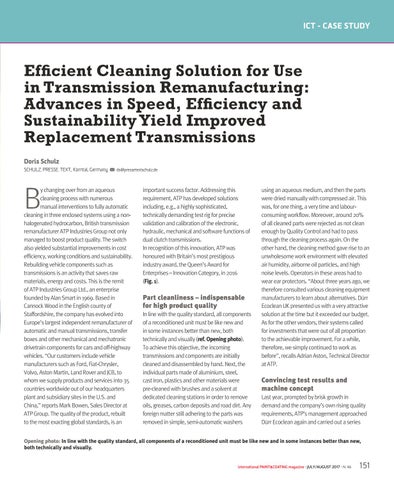ICT - CASE STUDY
Efficient Cleaning Solution for Use in Transmission Remanufacturing: Advances in Speed, Efficiency and Sustainability Yield Improved Replacement Transmissions Doris Schulz SCHULZ. PRESSE. TEXT., Korntal, Germany
B
ds@pressetextschulz.de
y changing over from an aqueous cleaning process with numerous manual interventions to fully automatic cleaning in three enclosed systems using a nonhalogenated hydrocarbon, British transmission remanufacturer ATP Industries Group not only managed to boost product quality. The switch also yielded substantial improvements in cost efficiency, working conditions and sustainability. Rebuilding vehicle components such as transmissions is an activity that saves raw materials, energy and costs. This is the remit of ATP Industries Group Ltd., an enterprise founded by Alan Smart in 1969. Based in Cannock Wood in the English county of Staffordshire, the company has evolved into Europe’s largest independent remanufacturer of automatic and manual transmissions, transfer boxes and other mechanical and mechatronic drivetrain components for cars and off-highway vehicles. “Our customers include vehicle manufacturers such as Ford, Fiat-Chrysler, Volvo, Aston Martin, Land Rover and JCB, to whom we supply products and services into 35 countries worldwide out of our headquarters plant and subsidiary sites in the U.S. and China,” reports Mark Bowen, Sales Director at ATP Group. The quality of the product, rebuilt to the most exacting global standards, is an
important success factor. Addressing this requirement, ATP has developed solutions including, e.g., a highly sophisticated, technically demanding test rig for precise validation and calibration of the electronic, hydraulic, mechanical and software functions of dual clutch transmissions. In recognition of this innovation, ATP was honoured with Britain’s most prestigious industry award, the Queen’s Award for Enterprises – Innovation Category, in 2016 (Fig. 1).
Part cleanliness – indispensable for high product quality In line with the quality standard, all components of a reconditioned unit must be like new and in some instances better than new, both technically and visually (ref. Opening photo). To achieve this objective, the incoming transmissions and components are initially cleaned and disassembled by hand. Next, the individual parts made of aluminium, steel, cast iron, plastics and other materials were pre-cleaned with brushes and a solvent at dedicated cleaning stations in order to remove oils, greases, carbon deposits and road dirt. Any foreign matter still adhering to the parts was removed in simple, semi-automatic washers
using an aqueous medium, and then the parts were dried manually with compressed air. This was, for one thing, a very time and labourconsuming workflow. Moreover, around 20% of all cleaned parts were rejected as not clean enough by Quality Control and had to pass through the cleaning process again. On the other hand, the cleaning method gave rise to an unwholesome work environment with elevated air humidity, airborne oil particles, and high noise levels. Operators in these areas had to wear ear protectors. “About three years ago, we therefore consulted various cleaning equipment manufacturers to learn about alternatives. Dürr Ecoclean UK presented us with a very attractive solution at the time but it exceeded our budget. As for the other vendors, their systems called for investments that were out of all proportion to the achievable improvement. For a while, therefore, we simply continued to work as before”, recalls Adrian Aston, Technical Director at ATP.
Convincing test results and machine concept Last year, prompted by brisk growth in demand and the company’s own rising quality requirements, ATP’s management approached Dürr Ecoclean again and carried out a series
Opening photo: In line with the quality standard, all components of a reconditioned unit must be like new and in some instances better than new, both technically and visually.
international PAINT&COATING magazine - JULY/AUGUST 2017 - N. 46
151
